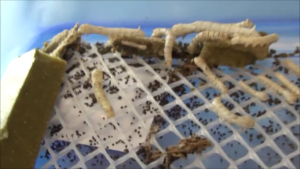 The rearing container in this image contains silkworm (Bombyx mori) larvae, which are consuming an artificial diet. This container must include everything the larvae need to complete their development and to move on to their next life-stage, ultimately to become reproductive adults that will mate, lay fertile eggs and continue to propagate on a continuous basis. This means that the food must be adequate, the “management” of their waste products (fecal material or frass, and carbon dioxide) must be accommodated, as must the provision of oxygen, proper temperature, light conditions, humidity, and all other aspects of their biology. Therefore, in our program, we think of the discovery of all the requirements and the understanding of as much of the mechanistic (cause and effect) relationships as possible leads to a high probability of conducting a successful rearing program. The cage and the rearing room are in a very realistic sense the insects’ microcosm of their universe. Insect rearing is the science and technology of understanding this universe.
The rearing container in this image contains silkworm (Bombyx mori) larvae, which are consuming an artificial diet. This container must include everything the larvae need to complete their development and to move on to their next life-stage, ultimately to become reproductive adults that will mate, lay fertile eggs and continue to propagate on a continuous basis. This means that the food must be adequate, the “management” of their waste products (fecal material or frass, and carbon dioxide) must be accommodated, as must the provision of oxygen, proper temperature, light conditions, humidity, and all other aspects of their biology. Therefore, in our program, we think of the discovery of all the requirements and the understanding of as much of the mechanistic (cause and effect) relationships as possible leads to a high probability of conducting a successful rearing program. The cage and the rearing room are in a very realistic sense the insects’ microcosm of their universe. Insect rearing is the science and technology of understanding this universe.
In our rearing studies, we recognize that the components of the rearing systems (the insects, their microbial associates, their food, and their environment) are all integrated in the most complex of associations. We further realize that there is a reciprocal relationship between the knowledge required to rear insects with complete success and what we can learn from the insects by putting them under our rearing conditions. Finally, we are always mindful in our studies that the insects that we take from their homes in the wild are being put through a domestication process, and that by deliberate and most often inadvertent selection, we are producing insects that differ to varying degrees from their native ancestors.
The silkworms in the pictures above, began their domestication journey in China about 5000 years ago!

